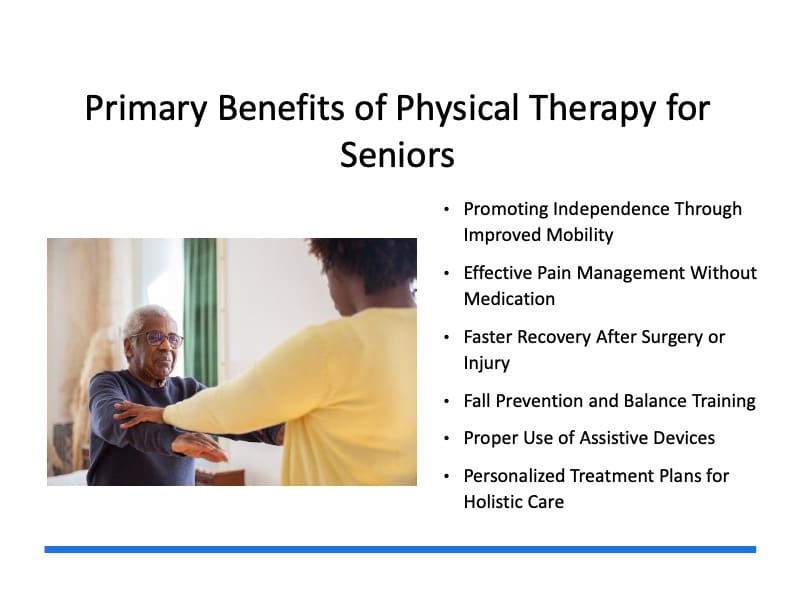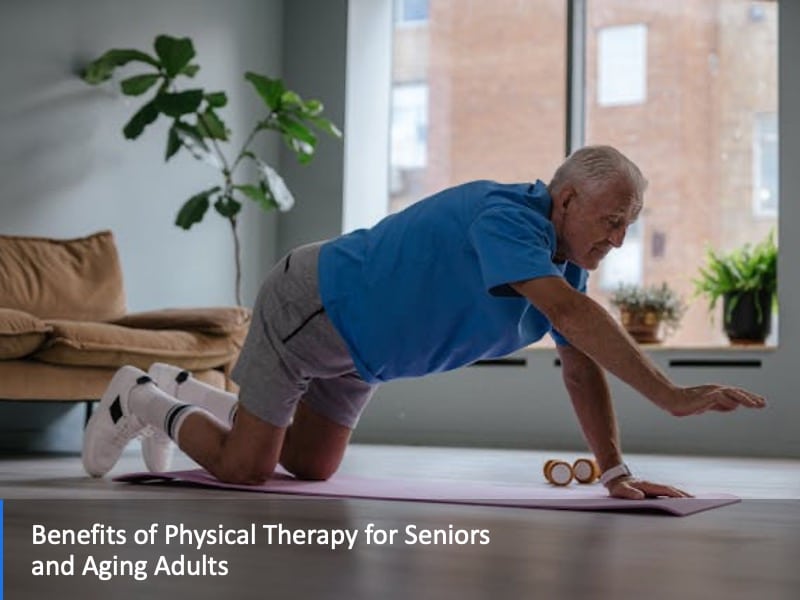Benefits of Physical Therapy for Seniors and Aging Adults
The benefits of physical therapy for seniors extend far beyond injury recovery, offering a powerful way to maintain independence, manage age-related conditions, and improved overall quality of life.
As we grow older, maintaining independence and mobility becomes vital for overall well-being.
Age-related conditions such as arthritis, osteoporosis, and sarcopenia can limit movement and quality of life, making even simple daily tasks more difficult.
Fortunately, senior care physiotherapy offers seniors and aging adults the tools to regain strength, reduce pain, and stay active longer.
Through personalized interventions and targeted exercise programs, physical therapy for seniors empowers aging adults to maintain autonomy and live healthier, more fulfilling lives.
What Is Physical Therapy?
Physical therapy (PT) is a healthcare discipline that uses evidence-based techniques to restore, maintain, and improve physical function and mobility.
PT combines movement science, manual therapy, patient education, and therapeutic exercises to address a wide range of physical limitations caused by injury, chronic disease, or aging.
For seniors, PT focuses on enhancing flexibility, balance, strength, and coordination—while reducing fall risk and promoting functional independence.
Licensed physical therapists assess an individual’s physical capabilities and design tailored plans to support safe and effective movement throughout daily life.
Types of Physical Therapy for Seniors and Aging Adults
Different forms of physical therapy cater to the specific needs of older adults, addressing both chronic conditions and acute rehabilitation.
Orthopedic Physical Therapy
This type focuses on musculoskeletal issues such as arthritis, joint replacements, fractures, and chronic back or neck pain.
It emphasizes joint mobilization, muscle strengthening, and restoring range of motion.
Neurological Physical Therapy
Aimed at seniors with neurological conditions such as Parkinson’s disease, stroke, or multiple sclerosis, this therapy enhances coordination, motor control, and balance through neuro-reeducation techniques.
Geriatric Physical Therapy
Geriatric physical therapy, tailored specifically to the aging population, addresses age-related challenges like bone density loss, postural instability, and reduced muscular strength using safe, gradual exercise progression (Criss et al., 2022).
Cardiopulmonary Rehabilitation
Designed for seniors recovering from heart attacks, cardiac surgery, or chronic respiratory issues, this therapy improves cardiovascular endurance, breathing techniques, and functional capacity.
Post-Surgical Rehabilitation
After joint replacements or orthopedic surgeries, physical therapy is crucial for rebuilding strength, restoring mobility, and reducing recovery time.
Primary Benefits of Physical Therapy for Seniors

As the body ages, physical limitations can gradually interfere with daily activities and overall quality of life.
Physical therapy provides aging adults with targeted strategies for preserving mobility, managing chronic pain, and regaining strength after injury or illness.
Whether used proactively or as part of rehabilitation, physical therapy helps seniors stay active, independent, and confident in their movements.
Promoting Independence Through Improved Mobility
Mobility is the foundation of independence.
As we age, everyday activities like walking, cooking, and dressing can become more challenging due to joint stiffness and decreased muscle function.
Physical therapy addresses these limitations with exercises targeting strength, coordination, and range of motion.
By improving physical performance, seniors can preserve their independence and reduce their need for assistance in daily life.
Effective Pain Management Without Medication
Chronic pain is a common challenge in older adults, especially from arthritis, spinal degeneration, or past injuries.
Physical therapy offers non-pharmacological pain relief through modalities like:
- Manual therapy and massage to reduce stiffness
- Heat and cold therapy to manage inflammation and soreness
- Targeted exercises that alleviate joint stress and support healing
Reducing dependence on pain medications also minimizes side effects and improves long-term health outcomes.
Faster Recovery After Surgery or Injury
Recovering from hip replacements, knee surgeries, or fractures can be especially demanding for seniors.
Physical therapy provides structured rehabilitation to rebuild strength, restore mobility, and improve overall function post-surgery (Hulsbaek et al., 2022).
Therapists guide patients through gradual progressions that reduce the risk of complications while promoting faster healing.
Supervised rehabilitation ensures safety and long-term recovery success.
Fall Prevention and Balance Training
Falls are one of the leading causes of injury among seniors.
Physical therapy reduces fall risk through:
- Balance exercises and proprioceptive training
- Strengthening the core and lower body
- Gait analysis and walking drills (Richards & Cristian, 2006)
Preventing falls not only protects physical health but also boosts confidence and reduces fear-related immobility.
Proper Use of Assistive Devices
When mobility tools like canes or walkers are necessary, physical therapists help seniors choose the right devices and learn how to use them correctly.
Improper use of assistive equipment can lead to injury or dependency.
Therapists also work to reduce long-term reliance on assistive devices by strengthening key muscle groups and promoting independent movement whenever possible.
Personalized Treatment Plans for Holistic Care
Each aging adult has unique medical history, goals, and physical challenges.
Physical therapists perform detailed assessments to create individualized plans that focus on the patient’s specific limitations and strengths.
This tailored approach ensures optimal safety and maximizes progress—whether the goal is to work for a couple more years, climb stairs, do more house cleaning, return to gardening, or simply walk without pain.
Final Thoughts: Why is Physical Therapy Important for Seniors and Aging Adults?
Physical therapy is a vital pillar of healthy aging, helping seniors move through life with strength, confidence, and reduced risk of injury.
As aging bodies naturally experience declines in muscle mass, joint mobility, and balance, physical therapy offers targeted interventions to maintain functional independence and overall vitality.
It’s not just about recovering from injury or surgery—physical therapy empowers seniors to stay active through personalized movement plans and safe progressions. These programs represent a model of safe fitness for seniors, designed to challenge the body while protecting it from strain or overexertion.
Physical therapy also builds the physical foundation for enjoying life beyond the clinic.
Whether it’s walking in the park, gardening, or playing sports, improved mobility opens the door to more meaningful daily experiences.
In fact, many aging adults use physical therapy as a stepping stone to participating in the best outdoor sports for seniors, such as golf, cycling, or swimming—all of which support cardiovascular health and social connection.
One rapidly growing activity that blends fun, fitness, and function is pickleball for seniors.
As a low-impact, social sport, it requires agility, coordination, and stamina—all of which can be improved and sustained through regular physical therapy sessions.
Above all, physical therapy supports the ability to age with grace and independence.
It strengthens the body, helps build confidence, and enhances quality of life, allowing seniors to add not only years to their lives but also life to their lives.



